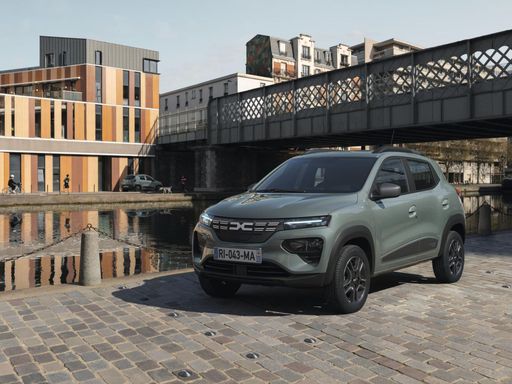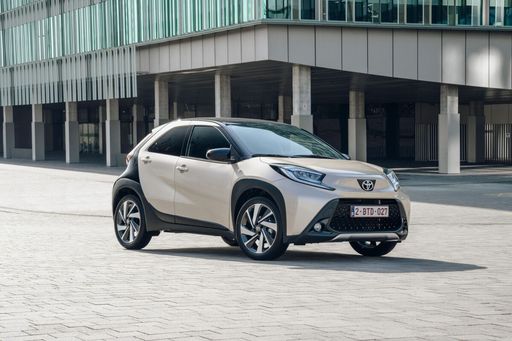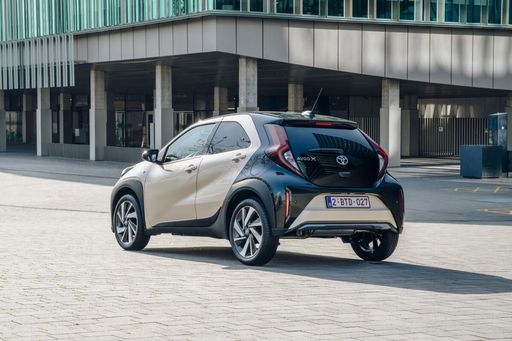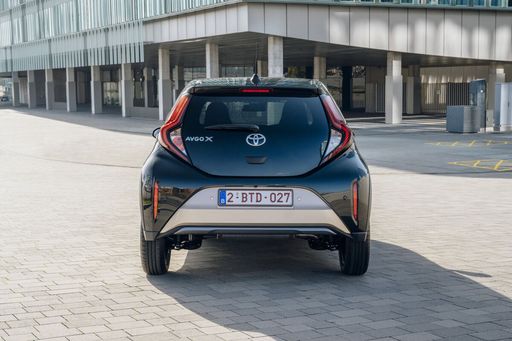Dacia Spring vs Toyota Aygo – Differences & prices compared
Compare performance, boot space, consumption and price in one view.
Find out now: which car is the better choice for you – Dacia Spring or Toyota Aygo?
The Dacia Spring (SUV) comes with a Electric engine and Automatic transmission. In comparison, the Toyota Aygo (SUV) features a Petrol engine with Manuel or Automatic transmission.
When it comes to boot capacity, the Dacia Spring offers 308 L, while the Toyota Aygo provides 231 L – depending on how much space you need. If you’re looking for more power, decide whether the 65 HP of the Dacia Spring or the 72 HP of the Toyota Aygo suits your needs better.
In terms of consumption, the values are 13.20 kWh per 100 km for the Dacia Spring, and 4.80 L for the Toyota Aygo.
Price-wise, the Dacia Spring starts at 14500 £, while the Toyota Aygo is available from 15500 £. Compare all the details and find out which model fits your lifestyle best!
In an intriguing comparison between the Dacia Spring and the Toyota Aygo, the Spring stands out with its groundbreaking electric design, offering an eco-friendly option for urban commuters. Meanwhile, the Toyota Aygo delivers a vibrant and agile driving experience with its compact dimensions and fuel-efficient engine, perfect for city navigation. While the Dacia Spring gives drivers an exciting glimpse into the electric future, the Toyota Aygo showcases the enduring appeal of traditional petrol-powered city cars.
Dacia Spring
The Dacia Spring stands out as an affordable and environmentally friendly option in the electric vehicle market, combining practicality with a compact design ideal for urban settings. Its minimalist interior, while basic, provides all the essential features needed for a comfortable drive, reflecting its cost-effective approach. The vehicle's performance suits city driving, making it an appealing choice for those seeking an entry-level electric car.
details @ dacia-presse.de
@ dacia-presse.de
 @ dacia-presse.de
@ dacia-presse.de
 @ dacia-presse.de
@ dacia-presse.de
Toyota Aygo
The Toyota Aygo presents itself as a compact city car, perfect for navigating tight urban spaces with ease. Its stylish design is complemented by a vibrant variety of colour options, making it a standout choice for those looking to express their individuality. Inside, the Aygo offers a comfortable and functional cabin, equipped with modern features that enhance the overall driving experience.
details @ Toyota
@ Toyota
 @ Toyota
@ Toyota
 @ Toyota
@ Toyota
 @ Toyota
@ Toyota
 @ Toyota
@ Toyota
 @ Toyota
@ Toyota
Compact Contenders: Dacia Spring vs. Toyota Aygo
In the competitive landscape of urban mobility, two compact cars stand out with their unique offerings: the Dacia Spring and the Toyota Aygo. As city-friendly SUVs, they promise practicality, efficiency, and a touch of innovation. Let's dive into the specifics to see how these two models compare in the race to win city dwellers' hearts.
Electric Zing vs. Petrol Precision
The Dacia Spring and the Toyota Aygo are based on two distinct powertrains—electric and petrol, respectively. The Dacia Spring is equipped with an electric motor offering a power output of up to 65 HP (48 kW) and a torque of 113 Nm. It's designed for those who are ready to embrace zero-emission driving with a CO2 rating of 0 g/km, making it extremely appealing for environmentally conscious buyers.
On the other hand, the Toyota Aygo is powered by a reliable 1.0-liter inline-three petrol engine, producing 72 HP (53 kW) and 93 Nm of torque. This petrol engine provides the regular car feel with familiarity in long-range cruising that some drivers value. It emits between 108 and 112 g/km of CO2, positioning it in the C efficiency class.
Efficiency and Range: Urban Prowess
The Dacia Spring leads in electric efficiency with consumption figures as low as 13.2 kWh/100km and an electric range of up to 228 km, making it perfect for daily urban commutes. The Toyota Aygo, meanwhile, boasts a fuel consumption of about 4.8 to 4.9 L/100km, offering a considerable range when fully fueled—the fuel tank capacity is 35 L.
Performance and Practicality
While neither of these cars is built for the track, they handle the cityscape with ease. The Dacia Spring accelerates from 0 to 100 km/h in a modest 13.7 seconds, while its top speed maxes out at 125 km/h, prioritizing economy over speed. In comparison, the Toyota Aygo does the same sprint in about 15.5 seconds with a top speed reaching up to 158 km/h, providing a bit more pep for open-road stretches.
Space and Comfort
Both models are compact SUVs with dimensions that manage urban environments efficiently. The Dacia Spring measures 3701 mm in length, 1583 mm in width, and 1519 mm in height. It offers a trunk capacity of 308 liters, making it slightly roomier for baggage than the Aygo.
The Toyota Aygo, just a millimeter shorter at 3700 mm in length, is wider at 1740 mm, providing more passenger space but with a slightly smaller trunk capacity of 231 liters. Both carry four passengers and feature five-door designs, enhancing their practicality.
Conclusion: Making the Urban Choice
The Dacia Spring and Toyota Aygo represent two intersecting trajectories in urban mobility: electrification versus conventional petrol. The former suits those keen on sustainability and lower running costs, while the latter offers a traditional driving experience with a wider range.
Whichever you choose, both are adept at tackling city streets. Whether you lean towards the cutting-edge greenness of the Dacia Spring or the tried-and-true spirit of the Toyota Aygo, these compact SUVs encapsulate the essence of modern urban driving.

|

|
|
|
|
Costs and Consumption |
|
|---|---|
|
Price
14500 - 17100 £
|
Price
15500 - 22100 £
|
|
Consumption L/100km
-
|
Consumption L/100km
4.8 - 4.9 L
|
|
Consumption kWh/100km
13.2 - 14.1 kWh
|
Consumption kWh/100km
-
|
|
Electric Range
225 - 228 km
|
Electric Range
-
|
|
Battery Capacity
26.80 kWh
|
Battery Capacity
-
|
|
co2
0 g/km
|
co2
108 - 111 g/km
|
|
Fuel tank capacity
-
|
Fuel tank capacity
35 L
|
Dimensions and Body |
|
|---|---|
|
Body Type
SUV
|
Body Type
SUV
|
|
Seats
4
|
Seats
4
|
|
Doors
5
|
Doors
5
|
|
Curb weight
1013 - 1050 kg
|
Curb weight
1015 kg
|
|
Trunk capacity
308 L
|
Trunk capacity
231 L
|
|
Length
3701 mm
|
Length
3700 mm
|
|
Width
1583 mm
|
Width
1740 mm
|
|
Height
1519 mm
|
Height
1510 mm
|
|
Payload
265 - 302 kg
|
Payload
345 kg
|
Engine and Performance |
|
|---|---|
|
Engine Type
Electric
|
Engine Type
Petrol
|
|
Transmission
Automatic
|
Transmission
Manuel, Automatic
|
|
Transmission Detail
Reduction Gearbox
|
Transmission Detail
Manual Gearbox, CVT
|
|
Drive Type
Front-Wheel Drive
|
Drive Type
Front-Wheel Drive
|
|
Power HP
44 - 65 HP
|
Power HP
72 HP
|
|
Acceleration 0-100km/h
13.7 - 19.1 s
|
Acceleration 0-100km/h
15.5 - 15.6 s
|
|
Max Speed
125 km/h
|
Max Speed
151 - 158 km/h
|
|
Torque
113 - 125 Nm
|
Torque
93 Nm
|
|
Number of Cylinders
-
|
Number of Cylinders
3
|
|
Power kW
33 - 48 kW
|
Power kW
53 kW
|
|
Engine capacity
-
|
Engine capacity
998 cm3
|
General |
|
|---|---|
|
Model Year
2024
|
Model Year
2024 - 2025
|
|
CO2 Efficiency Class
A
|
CO2 Efficiency Class
C
|
|
Brand
Dacia
|
Brand
Toyota
|
Dacia Spring
The Revolution of Affordable Electric Mobility: The Dacia Spring
The automotive world has witnessed remarkable advancements in electric vehicles (EVs), with the Dacia Spring emerging as a noteworthy contender in the affordable segment. Combining efficiency, affordability, and practicality, the Spring offers an intriguing prospect for eco-conscious individuals and city dwellers alike.
Powertrain and Performance: A Look Under the Hood
The Dacia Spring is equipped with an electric motor that delivers between 44 to 65 PS, translating into a versatile driving experience tailored to urban landscapes. It operates on a front-wheel-drive system, ensuring a familiar and manageable handling experience.
Dacia Spring's electric engine is paired with an automatic transmission, utilising a reduction gearbox. This setup allows for smooth acceleration and a top speed of 125 km/h, ensuring that everyday driving scenarios are handled with ease.
Efficiency and Range: Eco-Friendly without Compromise
Efficiency is a cornerstone of the Dacia Spring's design, boasting an energy consumption of just 13.2 to 14.1 kWh per 100 km. When fully charged, its 26.8 kWh battery offers a respectable range of 225 to 228 km, making it ideal for daily commutes and short trips.
Furthermore, the Spring takes pride in its commendable CO2-efficiency class A, emphasising its commitment to reducing environmental footprint with a zero-emission profile.
Design and Practicality: Compact yet Comprehensive
Lying in the SUV category, the Dacia Spring is compact with dimensions of 3701 mm in length and 1583 mm in width, making it a perfect match for urban environments where space is at a premium. Despite its modest size, it provides a generous boot space of 308 litres, ensuring practicality isn’t sacrificed.
Comfort and Interior: For the Everyday Journey
The Dacia Spring comfortably seats up to four passengers. The cabin offers a minimalist yet functional design, available in multiple trim lines including Essential, Expression, and Extreme, allowing customers to choose according to their taste and requirement.
With its ergonomic layout and simplicity, the interior is crafted to enhance the driving experience by focusing on essential needs, avoiding unnecessary distractions.
Affordability and Accessibility: Breaking Barrier
The Dacia Spring stands out in the electric vehicle market due to its affordability, with prices ranging from 16,900 to 19,900 €. This ensures that environmentally friendly transportation is accessible to a broader audience.
Additionally, the Spring allows for cost-effective maintenance and operational expenses, offering monthly running costs between 570 to 599 € and cost per km between 22.8 to 24 cents, making it an economical choice in the long run.
Final Thoughts: The Future of Urban Mobility
In summary, the Dacia Spring serves as a testament to how electric vehicles can be both affordable and practical, without compromising on essential features. Whether it is for the eco-conscious urbanite or those looking for a cost-effective daily driver, the Spring is positioned as a viable solution for navigating the future of urban mobility.
Toyota Aygo
The Urban Maverick: Exploring the Toyota Aygo
The Toyota Aygo has long been a favourite for city dwellers and those who appreciate a compact yet stylish vehicle. With its latest iterations, the Aygo promises to deliver a blend of efficiency, modernity, and cutting-edge technology. Let's take a closer look at what this impressive vehicle has to offer.
Under the Bonnet: Technical Specifications
At the heart of the Toyota Aygo is a 1.0-litre three-cylinder engine. This petrol-powered engine is capable of producing 72 PS (53 kW) and offers a maximum torque of 93 Nm. The efficient engine achieves a fuel consumption of just 4.8 to 4.9 L/100km, making it an economical choice for urban commuting. The car features a front-wheel-drive layout and is available with either a manual transmission or a CVT automatic gearbox, providing flexibility for various driving preferences.
Performance on the Road
Despite its compact size, the Toyota Aygo offers a respectable acceleration from 0 to 100 km/h in just 15.5 to 15.6 seconds, with a top speed ranging between 151 and 158 km/h. This makes it well-suited for both city driving and highway cruising. The car's lightweight design of 1,015 kg ensures nimble handling and manoeuvrability in tight urban environments.
Design and Dimensions
The Aygo's contemporary exterior design is both attractive and functional. It measures 3,700 mm in length, 1,740 mm in width, and 1,510 mm in height, offering a compact footprint without sacrificing interior space. With five doors and four seats, the Aygo is practical for everyday use. The vehicle provides a boot space of 231 litres, ensuring you have enough room for groceries and luggage on the go.
Innovation and Features
The Toyota Aygo is equipped with a range of innovative features, enhancing the driving experience. Available in several trim levels including Business Edition, Explore, and Style, each comes with its own unique set of features. Standard offerings across trims include advanced safety features, a modern infotainment system, and optional extras such as climate control and advanced connectivity options.
Environmental Considerations and Efficiency
In line with environmental consciousness, the Toyota Aygo carries a CO2 efficiency class of C, with emissions ranging from 108 to 112 g/km. This ensures that the vehicle not only provides an efficient driving experience but also minimises its environmental impact. Additionally, the running costs are attractive, with estimated costs per kilometre between 27.4 and 31.3 cents, and monthly costs ranging from €685 to €783.
Pricing and Market Appeal
The Toyota Aygo is positioned competitively within the market, with pricing starting from €17,550 and reaching up to €23,950, depending on the selected trim and options. Its affordability, combined with its efficient performance and modern features, makes it an appealing choice for a wide range of buyers, particularly those seeking a reliable and economical vehicle for urban environments.
In conclusion, the Toyota Aygo stands out as a versatile and stylish city car that combines practicality with a touch of sophistication. Whether you're navigating busy urban streets or cruising on the motorway, the Aygo is well-equipped to handle the journey with ease and efficiency.
Is the Dacia Spring offered with different drivetrains?
Available configurations include Front-Wheel Drive.
The prices and data displayed are estimates based on German list prices and may vary by country. This information is not legally binding.
